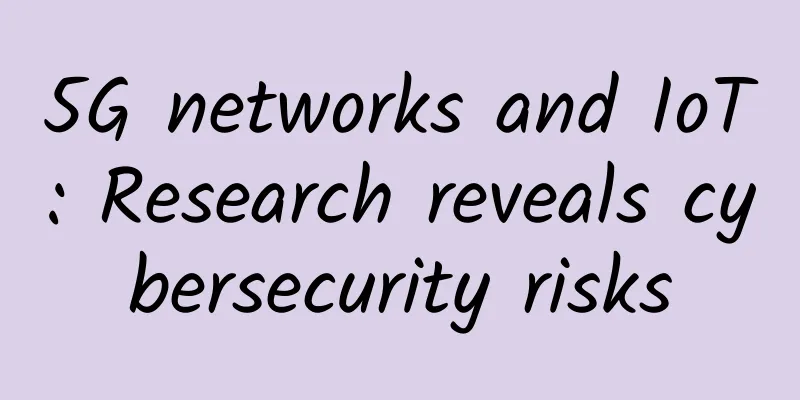5G networks and IoT: Research reveals cybersecurity risks

|
The researchers said the risks of 5G networks are amplified by the sheer number of devices connected and the sensitivity of the data they will process. 5G is expected to be a key component in the continued development of digital technology, especially as artificial intelligence (AI) and the Internet of Things (IoT) continue to reshape the global technology landscape. Like previous networks, 5G networks are not immune to security threats. However, the risks are amplified by the sheer number of devices that will be connected and the sensitivity of the data they will process. Cybersecurity issues include privacy and data protection, as well as potential threats to critical infrastructure. The decentralized nature of 5G networks and the processing of more data also bring new vulnerabilities. Telecom operators and equipment manufacturers need to invest heavily in strong cybersecurity measures to protect against these threats. Why is IoT cybersecurity important?The Internet of Things refers to all objects and devices connected to the Internet, which can accumulate and transmit data without any human intervention. However, delegating control to the Internet exposes IoT devices to potential cyber attacks and destructive intervention. With IoT completely changing the rules of the game, cybersecurity has become more important than ever, while also challenging. According to the report, 98% of IoT device traffic is not encrypted, exposing personal and sensitive data on the network. This is a great example of IoT cyber risks. The report also highlights that 57% of IoT devices are vulnerable to attacks of medium or high severity. In addition, 41% of attacks exploit device vulnerabilities, which once again highlights the IoT security challenges. 5G technology and network security issues5G will bring countless cybersecurity risks as well as its advantages. Therefore, enterprises will have to invest heavily in cybersecurity to fully utilize 5G. The evolution of 4G technology to 5G technology has brought new challenges to cybersecurity, and the currently operating cybersecurity technology is not enough to prevent the new threats it brings. 5G technology brings many threats to network security due to the use of big data. Due to the large amount of data used by 5G, it requires a lot of network protection. Therefore, the increase in 5G use brings new network security threats. The world is heading towards the fifth industrial revolution. This will bring advanced mechanization, mass production of cars, artificial intelligence, the Internet of Things, and cyber-physical systems. While all these innovations are very useful for humans, these technologies can easily become targets for hackers. This shows that 5G will have a positive impact on our lives, but it will also bring cybersecurity risks. Problems with the future of 5G networksAs mentioned earlier, as 5G continues to evolve and become more prevalent, new challenges may arise. Here are some potential future issues that stakeholders should be aware of: Network congestionAlthough 5G networks are designed to handle larger data volumes and devices than their predecessors, the rapid growth in the number of connected devices could still lead to network congestion. This could result in slower speeds and reduced performance, especially in densely populated urban areas. Cybersecurity threatsAs mentioned earlier, as more devices connect to 5G networks, the potential for cybersecurity threats increases. This could include data breaches, identity theft, and attacks on critical infrastructure. The industry needs to stay ahead of these threats by investing in strong security measures and continually updating and improving them. Regulatory challengesThe deployment of 5G networks is likely to present regulatory challenges. These include issues related to spectrum allocation, data privacy, and health and safety. Regulators will need to balance the need for innovation and growth with the need to protect consumers and maintain network integrity. |
<<: AI and 5G synergy: Unleashing the full potential of the digital age
>>: Efficiently build vivo enterprise-level network traffic analysis system
Recommend
Today, China’s 5G is two years old!
On October 31, 2019, the first day of the 28th Ch...
A 20,000-word in-depth introduction to distributed systems
WeTest Introduction We often hear about how aweso...
Is it necessary to upgrade from 4G to 5G mobile phone now?
As 5G network coverage continues to expand rapidl...
Wi-Fi 7: The Next Generation of Wi-Fi Evolution
Although Wi-Fi 6 has just been launched, Wi-Fi 7 ...
Huawei aims to be a smart city incubator providing basic energy
During the just concluded National People's C...
NTT and Cisco team up to provide integrated collaborative communications solutions
NTT and Cisco jointly provided an integrated coll...
When to use 5G and Wi-Fi 6?
We’ve seen a lot of hype around 5G cellular and W...
Eleven things to note when using natural cooling technology in data centers
The Green Grid, a non-profit organization dedicat...
Three ways to send large amounts of data over HTTP
In the early days of the web, people sent files t...
"5G IoT, Smart Journey" - China Unicom IoT shines at 2020 Beijing Communications Exhibition
From October 14 to 16, the 2020 China Internation...
Which unlimited package of the three major operators is more cost-effective? Detailed comparison
Starting from July 1 this year, China Mobile, Chi...
SpeedyPage: $5.39/month KVM-AMD Ryzen, 2G memory, 30G NVMe, 5TB/month, Singapore data center
SpeedyPage is a foreign hosting company establish...
VirMach: $7.2/year KVM-512MB/10GB/1TB/multiple data centers available
VirMach has launched the SUMMER HOSTSALE promotio...
Megalayer: Hong Kong/Singapore/US VPS annual payment starts from 199 yuan or 24 yuan/month, dedicated server starts from 399 yuan/month
Megalayer is a foreign hosting company establishe...
Friendhosting Halloween 30% off, 13 data center VPS monthly payment from 2.1 euros
Friendhosting has launched this year's Hallow...









